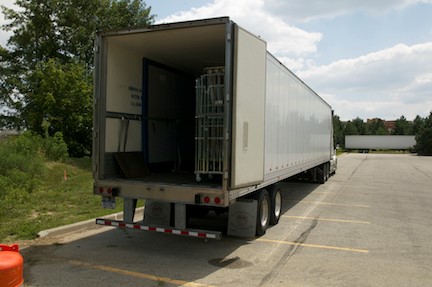A. Coverage
The insurance company
pays amounts an insured is legally obligated to pay as damages because of bodily injury or property damage
and certain types of pollution events (see definition of covered
pollution cost or expense). However, the obligation to pay is triggered only by
accidental occurrences involving vehicles covered under the Motor Carrier
Coverage Form. An eligible pollution event is covered only if it is connected
to a covered bodily injury or property damage loss.
Besides responding to
valid claims, the insurance company has an obligation and a right to provide a
legal defense related to a claim. The insurance company has sole responsibility
as to which claims are denied, settled, investigated, or defended. All defense-related obligations end once an action
is resolved by a settlement, a court award, or when the limit of insurance that
applies is exhausted. This is true even if additional claims, losses, or suits
are filed against the insured.
|

|
Example: Hurryup Transport does
not properly maintain its oldest, large tractor-trailer unit. During
its latest trip, the brakes failed, causing an accident that involved four
vehicles and multiple claimants. The insurance company realized that Hurryup was at fault in the accident and
settled out of court with as many of the claimants as the limits allowed.
Once the limits were exhausted, the company no longer had to provide Hurryup with a legal defense against the
remaining claimants and Hurryup was
left to bear the entire cost of the remaining legal expenses by itself.
|
1. Who Is an Insured
a. The named insured is an insured for any
covered auto.
b. Anyone else who
has permission from the named insured to use a covered auto that the named
insured owns, hires or borrows is an insured but there are some exceptions. The
following persons are not insureds.
(1) The owner of the covered auto and
any of the owner’s employees, drivers or agents are not insureds. Any other
party from whom the insured hired or borrowed a covered auto is also not an insured.
(2) The
named insured's employees or agents are not insureds if the employees, agents
or members of their households own the auto.
Note:
If an employee borrows her son’s car to pick a client up at the airport, that
employee is not an insured.
(3) When the covered auto is being worked on, the
individual doing the work is not an insured if he or she is in the
business of selling, servicing, repairing, parking, or storing autos. However,
those individuals are insureds if the named insured owns the business.
(4) Anyone
moving property to or from a covered auto
is not an insured but there are exceptions. The named insured’s partners, employees,
and members of a limited liability company are covered, as well as lessees and
borrowers of autos, including their employees.
|
Example: Bill allows Jack, one of his friends, to use one of Hurryup’s trucks to move his household
property. Jack is not an insured when he loses control of his piano and it
strikes his new neighbor.
|

|
(5) The
named insured's partners or members are not insureds for a covered private
passenger auto they or members of their households own.
c. The owner of a trailer that the named insured
hires or borrow is an insured. Others from whom the named insured hires
or borrows trailers are also insureds. However,
this status for the owner and for the others applies only while such trailers
are attached to a covered power unit or, if not attached, are used exclusively
in the named insured's business.
d. Any party that
is leasing a non-trailer covered auto to the named insured is an insured only
if all of the following apply:
- There is a written agreement
- The written agreement does not require the lessor to hold the
named insured harmless
- The leased auto is used in the named insured carrier-for-hire
business
Employees, agents or
drivers of the lessor are insured if the party leasing the auto to the named
insured is considered an insured.
e. Parties liable
for the conduct of any insured described above are also insureds to the extent
of their liability.
The following are not
insureds:
(1) Other than the
named insured and its employees, any carrier-for-hire and its agents or
employees that is:
(a) Subject
to motor carrier insurance requirements and does not use auto liability
insurance to meet them
(b) Not
covered for primary hired autos liability that insures
the parties that own the autos and their employees and agents while the hired
autos are used exclusively in that party’s business.
This (1) does not apply when the named insured uses a written agreement
to lease an auto to the carrier for hire
when that lease holds that carrier
harmless.
(2) When a trailer
is detached from a covered auto and is being transported, the rail, water, or
air carriers providing the transport are not insureds. This applies only when
the covered auto is being loaded, transported, or unloaded by the carrier.
Related Court Case: 220_C141, Told You So: Insurer Disclaims Coverage
Note: One of the
important differences in Who Is an Insured in this coverage form compared to
the old Truckers Coverage Form is the section dealing with the named insured’s
business operations. The Truckers Coverage Form specifically referred to the
named insured’s business as a trucker and to the operating rights granted by a
public authority. The Motor Carrier Coverage Form does not.